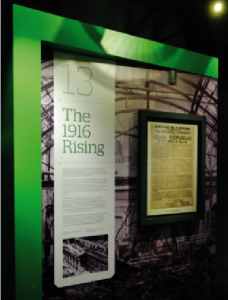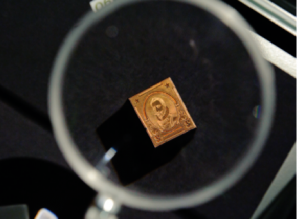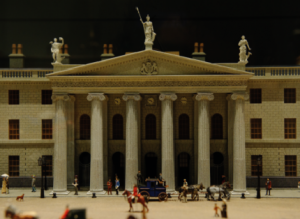Lives, Letters and Liberty— An Post Museum
Published in Issue 2 (March/April 2015), Reviews, Volume 23
The chosen themes of the museum reflect the GPO’s role as the headquarters of the postal service in Ireland and also as the headquarters of the rebels in Easter Week 1916.
(All images: An Post Museum)
An Post’s museum is located in the historic General Post Office on O’Connell Street, which itself is due to be the centre of much attention next year, the centenary of the 1916 Rising. The chosen themes of the museum reflect its role as the headquarters of the postal service in Ireland and also as the headquarters of the rebels in Easter Week 1916, although after visiting the museum I felt that boats, trains, planes and automobiles might be more appropriate themes, as they all played their part in delivering the mail over the centuries.
Occupying a comparatively small area off the main concourse of the GPO, the museum makes maximum use of the space it has. There are actual artefacts and information panels but excellent use is made of videos, which engagingly relay different aspects of Irish postal history and bring the people involved to life.
The first room concentrates on philately, i.e. stamps, with screens showing a database of the different issues of stamps since independence. Display cabinets contain a selection of postcards through the ages, a 1960s telephone, letter scales, a Morse telegraphy key and more. Along one wall is a series of drawers that can be pulled out to reveal stamps from Ireland and around the world. One wall is dedicated to the artists who designed Irish stamps, such as Lily Williams, Wendy Walsh and P.J. Lynch.
The main exhibition area is divided into sections covering themes like ‘The Post Office in Ireland’, ‘Post Through the Ages’, ‘Letter Writing’ and so on. A time-line explains the development of the postal service in Ireland from the sixteenth century to the present, including the initiation of a transatlantic service in the 1930s using flying boats based at Foynes, Co. Limerick. Things to look out for here are uniforms from different eras, a writing bureau featuring letters over the centuries (including some sent during the Great Famine), an early twentieth-century telephone operator’s station and a large architectural model of the GPO itself. Almost all of these include videos of topics associated with them. Nearby, a series of individuals, from Capt. John Skinner in the eighteenth century to Billy Boyle in the twentieth, highlight the lives of those who made the Post Office what it is today.
You can’t miss the reconstruction of a travelling post office (TPO). This is a railway carriage designed as a sorting office and an example of how the railway revolutionised postal delivery. The videos here explain how the idea came about and how it worked in practice. The trains that ran from Dublin to all the major cities not only had staff on board to sort out the mail for their destinations but also, through an ingenious device known simply as the ‘apparatus’, could collect mailbags from small stations along the way without having to stop. The TPO was just like a regular sorting office, with pigeonholes lining its walls and counters for the postmen to sort out the letters. So successful was the service that the last one was not phased out until 1994.
Here, too, is a plaque to commemorate the 21 members of the Dublin Post Office who died when the RMS Leinster was torpedoed by a German U-boat on 10 October 1918. This is a reminder not only that ships played an important role in the postal service—the Titanic was a Royal Mail ship, after all—but also that members of the service put their lives at risk during the First World War.
Not far from the TPO is an exhibit dedicated to the 1916 Rising. One enters a booth that contains a screen on which life-like figures appear, recounting the events that occurred when Patrick Pearse and his comrades took over the GPO as their headquarters. Of course, the statue of Cuchulain in the main concourse is a formal memorial of that fateful week. We can expect a more elaborate exhibition on 1916 next year.

A 1911 Chilean wooden block stamp showing the conquistador Pedro de Valdivia. The style and design were highly influential in the production of Ireland’s first set of stamps in 1922.
I have to admit that I was not expecting much from this museum when I went there. I found it to be a fascinating experience, however. I knew something of the history of the postal service but had no idea how complex and interesting it was. The museum traces that history from rudimentary beginnings through the formation of an established service to the origins and development of An Post. It may surprise some, including me, to discover that Oliver Cromwell set up the first daily postal service between Ireland and England, or that the original post-boys were men on horseback.
The museum conveys the facts, big and small, in a packed space. It is, by the by, a welcome respite from the noise and bustle of O’Connell Street, and I would recommend it for a visit. On the day I was there a group of secondary school students were being shown around by a member of the GPO staff, and it was amazing to see how enthralled this smartphone generation were by the pre-digital age. But hurry, it will be closing in early summer 2015 to make way for GPO: Witness History, an extended exhibition and interpretative centre, a flagship project in the state-funded centenary commemorations of the 1916 Rising. The official opening will be in Easter 2016 but Museum Eye has been promised a sneak preview before then.
Tony Canavan is the editor of Books Ireland.

















